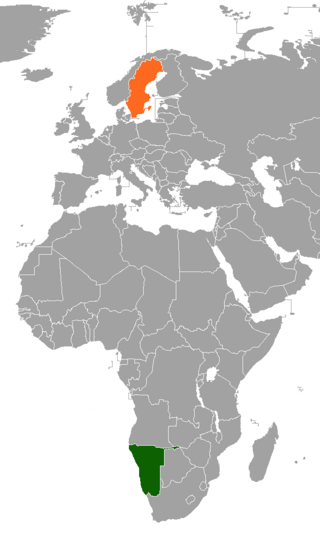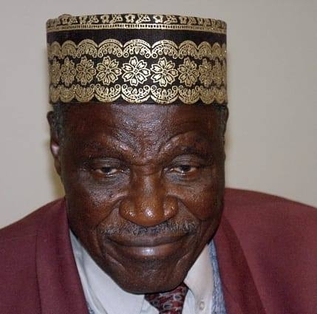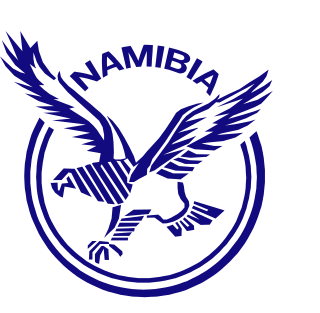
Namibia, officially the Republic of Namibia, is a country in Southern Africa. Its western border is the Atlantic Ocean. It shares land borders with Angola and Zambia to the north, Botswana to the east and South Africa to the east and south. Although it does not border Zimbabwe, less than 200 metres of the Botswanan right bank of the Zambezi River separates the two countries. Its capital and largest city is Windhoek.
The history of Namibia has passed through several distinct stages from being colonised in the late nineteenth century to Namibia's independence on 21 March 1990.

Windhoek is the capital and largest city of Namibia. It is located in central Namibia in the Khomas Highland plateau area, at around 1,700 m (5,600 ft) above sea level, almost exactly at the country's geographical centre. The population of Windhoek, which was 486,169 in 2023, is constantly growing due to a continued migration from other regions in Namibia.

The Canadian National Exhibition (CNE), also known as The Exhibition or The Ex, is an annual event that takes place at Exhibition Place in Toronto, Ontario, Canada, on the third Friday of August leading up to and including Labour Day, the first Monday in September. With approximately 1.6 million visitors each year, the CNE is Canada's largest annual community event and one of the top fairs in North America. The fair is a combination of agricultural exhibits and events, carnival rides and entertainment, live music, food and special events. Special events include the Warriors Day Parade, the Labour Day Parade and the Canadian International Air Show.

A trade show, also known as trade fair, trade exhibition, or trade exposition, is an exhibition organized so that companies in a specific industry can showcase and demonstrate their latest products and services, meet with industry partners and customers, study activities of rivals, and examine recent market trends and opportunities.

Tourism in Namibia is a major industry, contributing N$7.2 billion to the country's gross domestic product. Annually, over one million travelers visit Namibia, with roughly one in three coming from South Africa, then Germany and finally the United Kingdom, Italy and France. The country is among the prime destinations in Africa and is known for ecotourism which features Namibia's extensive wildlife.

Ongwediva is a town in the Oshana Region in the north of Namibia. It is the district capital of the Ongwediva electoral constituency. As of 2023 it had 28,000 inhabitants and covered 4,102 hectares of land. Ongwediva has seven churches, two private schools and 13 government-run schools. Most of the inhabitants speak Oshiwambo.
Heroes' Day is a national public holiday in Namibia. It is recognized by the United Nations as Namibia Day. Celebrated annually on 26 August, the day commemorates the Namibian War of Independence which began on 26 August 1966 at Omugulugwombashe.

Heveningham is a village and civil parish in the East Suffolk district of Suffolk in eastern England. Located four miles south-west of Halesworth, in 2005 it had a population of 120.

Windhoek railway station is a railway station serving the city of Windhoek, the capital of Namibia. It is an important station in the Namibian rail network, and it is run by TransNamib.
The Rand Show, previously known as the Rand Easter Show, is an annual show held in Johannesburg, South Africa, and is the largest consumer exhibition in Southern Africa. It has been an important event in the city for many years, attracting in excess of 400,000 visitors in 2007. It was also called the Grand Rand Show, when it was held a few weeks outside of Easter in the late 1980s.

Namibia–Sweden relations refers to the bilateral relations between Namibia and Sweden. Namibia maintains an embassy in Stockholm, while Sweden closed its embassy in Windhoek in 2008. Sweden was a strong supporter of the Namibian independence movement. From Namibia's independence in 1990 until 2007, Sweden was a primary donor of aid to develop Namibia's public sector but, in 2007, development aid began to be scaled back.

The Namibia men's national cricket team, nicknamed the Eagles, is the men's team that represents the Republic of Namibia in international cricket. It is organised by Cricket Namibia, which became an associate member of the International Cricket Council (ICC) in 1992.

Namibia is an arid country that is regularly afflicted by droughts. Large rivers flow only along its northern and southern borders, but they are far from the population centers. They are also far from the country's mines, which are large water users. In order to confront this challenge, the country has built dams to capture the flow from ephemeral rivers, constructed pipelines to transport water over large distances, pioneered potable water reuse in its capital Windhoek located in the central part of Namibia, and built Sub-Saharan Africa's first large seawater desalination plant to supply a uranium mine and the city of Swakopmund with water. A large scheme to bring water from the Okavango River in the North to Windhoek, the Eastern National Water Carrier, was only partially completed during the 1980s.

John ya Otto Nankudhu was a Namibian guerrilla, army officer and politician. He was the commander of the forces of the People's Liberation Army of Namibia (PLAN) at Omugulugwombashe when the armed struggle for independence began there on 26 August 1966 and was later jailed for 17 years at Robben Island. He is a National Hero of Namibia for his contributions to the independence of the country.

The 2014 African Women's Championship, the 11th edition of the tournament, was held in Namibia. This tournament, organized by the Confederation of African Football, was also a qualification tournament for the 2015 FIFA Women's World Cup, with top three qualifying for the finals in Canada. It was played on 11–25 October 2014.

The Welwitschias, currently known as the Windhoek Draught Welwitschias due to sponsorship by Namibia Breweries Limited, are a Namibian rugby union team that often participates in South African domestic competitions. As of 2021, they are regular participants in the annual Rugby Challenge tournament, having previously played in the Currie Cup and Vodacom Cup.
The 2018–2021 Southern Africa drought was a period of drought that took place in Southern Africa. The drought began in late October 2018, and negatively affected food security in the region. In mid-August 2019, the drought was classified as a level 2 Red-Class event by the Global Disaster Alert and Coordination System. The alert level was reduced to the Orange-1.7 by 12 December 2019, as the new wet season had started. In September 2020, the drought was classified as a level 2 Red-Class event. The drought continued into early 2021. Beginning in October 2021, South Africa experienced above average rainfall and reservoirs refilled by early 2022.

Squatting in Namibia is the occupation of unused land or derelict buildings without the permission of the owner. European settlers arrived in the nineteenth century and acquired land, leaving only 38 per cent of land in indigenous hands by 1902. This led to squatting and the Herero Wars, which ended with the Herero and Namaqua genocide. After Namibian independence in 1990, squatting increased as people migrated to the cities and land reform became a goal for those who had participated in the liberation struggle. By 2020, 401,748 people were living in 113 informal settlements across the country. Squatting continues to be regulated by the Squatters Proclamation of 1985; a challenge to this law was dismissed by the High Court in 2023.














